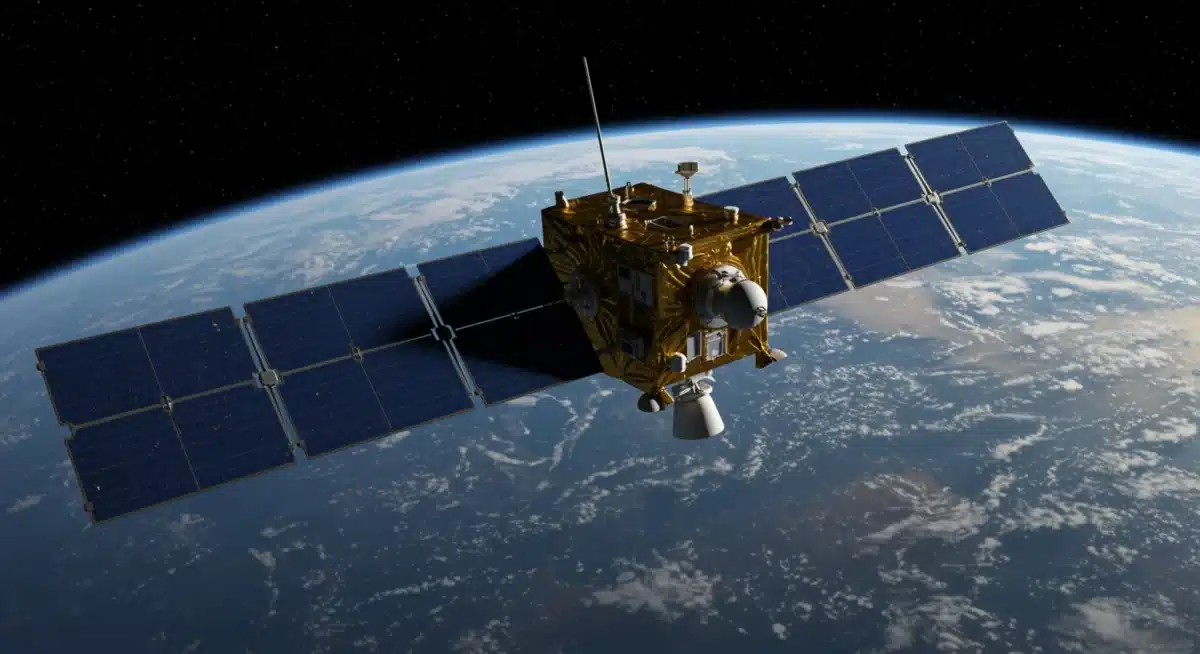Space Innovation: US Companies Leading the New Space Race

US companies are spearheading a new era of space exploration, leveraging cutting-edge technology and private investment to accelerate advancements in rocketry, satellite systems, and lunar missions, fundamentally reshaping global space endeavors.
The landscape of space exploration is undergoing a revolutionary transformation, with US space innovation at its very core. No longer solely the domain of government agencies, the new space race is being fiercely contested and largely driven by a dynamic ecosystem of American private companies. These trailblazers are pushing the boundaries of technology, economics, and ambition, redefining humanity’s reach into the cosmos. What does this mean for the future of space, and how are these companies setting the pace?
The Dawn of Commercial Spaceflight
The concept of commercial spaceflight has evolved from a futuristic dream into a tangible reality, largely thanks to the relentless pursuit of innovation by US-based companies. This paradigm shift has not only lowered the cost of accessing space but has also dramatically increased the frequency and diversity of missions. The privatization of launch services, satellite deployment, and even human spaceflight has opened up unprecedented opportunities for scientific research, economic development, and international collaboration.
For decades, space endeavors were primarily government-funded and operated, characterized by immense budgets and long development cycles. However, the emergence of agile private enterprises has injected a new level of competition and efficiency. These companies are not just building rockets; they are creating entire ecosystems that support a sustainable and expanding presence in space.
Reusable Rocket Technology
One of the most significant breakthroughs driving commercial spaceflight is the development of reusable rocket technology. This innovation has been a game-changer, fundamentally altering the economics of space access. By allowing launch vehicles to be recovered and reflown, the costs associated with each mission are drastically reduced, making space more accessible to a wider range of clients.
- Cost Reduction: Reusable rockets significantly cut down the per-launch expense, making satellite deployment and other space activities more affordable.
- Increased Launch Frequency: The ability to quickly refurbish and relaunch rockets shortens turnaround times, enabling more frequent missions.
- Environmental Impact: Reducing the amount of discarded rocket hardware in the ocean or as space debris offers environmental benefits.
- Technological Advancement: The engineering challenges overcome to achieve reusability have spurred further innovation in propulsion and materials science.
The impact of reusable rocket technology extends beyond mere cost savings. It fosters an environment where audacious projects become economically viable, paving the way for larger constellations of satellites, more frequent resupply missions to the International Space Station, and ambitious deep-space exploration initiatives. This new economic model is attracting significant private investment, further accelerating the pace of innovation and solidifying the US lead in the new space race.
Satellite Constellations and Global Connectivity
Beyond launch capabilities, US companies are revolutionizing global connectivity through the deployment of vast satellite constellations. These networks of thousands of interconnected satellites in low Earth orbit (LEO) promise to deliver high-speed, low-latency internet access to every corner of the planet, bridging the digital divide and enabling new applications in various sectors. The ambition behind these projects is immense, requiring unprecedented manufacturing scale, sophisticated orbital mechanics, and robust ground infrastructure.
The vision is to provide universal internet access, particularly to remote and underserved areas where traditional terrestrial infrastructure is impractical or too expensive to deploy. This has profound implications for education, healthcare, disaster relief, and economic development worldwide. The sheer number of satellites involved and the intricate coordination required represent a monumental engineering and logistical feat.
Impact on Terrestrial Networks
The rise of LEO satellite constellations is poised to have a transformative effect on existing terrestrial communication networks. While not designed to entirely replace fiber optics or 5G in densely populated urban centers, these satellite systems offer a complementary solution, especially in challenging environments. They provide a resilient layer of connectivity that can bypass geographical barriers and offer redundancy in times of crisis.
- Rural Broadband: Bringing high-speed internet to isolated communities, fostering economic growth and access to essential services.
- Emergency Communications: Providing critical connectivity during natural disasters when ground infrastructure is compromised.
- IoT and M2M: Enabling widespread deployment of Internet of Things devices and machine-to-machine communication in remote locations.
- Maritime and Aviation: Offering reliable internet access for ships and aircraft, improving safety and operational efficiency.
The competition in this sector is fierce, with multiple US companies vying to establish their constellations. This competitive landscape drives continuous innovation in satellite design, propulsion, and ground station technology, ensuring that the services offered are increasingly robust and affordable. The ability to manufacture and launch thousands of satellites efficiently is a testament to American manufacturing prowess and technological ingenuity in the space sector.
Lunar Ambitions and Beyond: The Return to the Moon
The moon, once the ultimate frontier of human exploration, is re-emerging as a focal point for US space innovation, but with a fundamentally different approach. The new lunar race is characterized by a strong commercial component, with private companies playing a pivotal role in developing technologies for lunar transportation, resource utilization, and even permanent habitats. This renewed interest is driven by scientific curiosity, strategic resource potential, and the moon’s role as a stepping stone for deeper space missions, particularly to Mars.
US companies are developing a range of lunar landers, rovers, and support systems designed to facilitate both robotic and human missions. These endeavors are often conducted in partnership with NASA’s Artemis program, which aims to return humans to the lunar surface. The collaboration between government agencies and private industry is accelerating progress, leveraging the agility and innovation of the private sector with the scientific expertise and long-term vision of NASA.

Lunar Resource Utilization
One of the most compelling aspects of the new lunar strategy is the focus on resource utilization, often referred to as In-Situ Resource Utilization (ISRU). The moon is believed to harbor significant reserves of water ice, particularly in its permanently shadowed craters at the poles. This water ice is not only vital for sustaining human presence but can also be broken down into hydrogen and oxygen, which are critical components for rocket fuel.
- Water Extraction: Developing technologies to locate, extract, and process water ice for drinking, oxygen, and fuel production.
- Energy Generation: Designing lunar power systems, including solar arrays and potentially small nuclear reactors, to support long-duration missions.
- Construction Materials: Investigating the use of lunar regolith (soil) for 3D printing structures and habitats, reducing the need to transport materials from Earth.
- Propellant Production: Creating rocket fuel from lunar resources, enabling missions to Mars and beyond without relying solely on Earth-launched fuel.
The prospect of establishing a sustainable lunar economy, fueled by locally sourced resources, represents a monumental leap forward in space exploration. US companies are at the forefront of developing the necessary technologies and operational strategies to make this a reality, laying the groundwork for a permanent human presence on the moon and a springboard for future interplanetary travel. This vision of an off-Earth economy is a powerful driver of US space innovation.
Advancements in Propulsion Systems
The quest for faster, more efficient, and more sustainable travel beyond Earth orbit is driving significant advancements in propulsion systems among US space companies. While traditional chemical rockets remain the workhorse for launches, innovative firms are exploring a diverse array of next-generation technologies. These new propulsion methods are crucial for reducing transit times to distant planets, enabling more complex deep-space missions, and facilitating asteroid mining operations. The ability to move payloads and people across vast cosmic distances more effectively is a cornerstone of future space endeavors.
The development of these advanced systems requires substantial investment in research and development, pushing the boundaries of material science, physics, and engineering. From electric propulsion to nuclear thermal rockets, the US aerospace sector is actively pursuing solutions that could redefine the scope and speed of space exploration, making previously unthinkable missions achievable within reasonable timeframes.
Electric and Ion Propulsion
Electric propulsion systems, such as ion thrusters, offer extremely high fuel efficiency, albeit with lower thrust compared to chemical rockets. These systems are ideal for long-duration missions where constant, low-level acceleration can eventually achieve very high speeds. They are particularly well-suited for satellite maneuvering, deep-space probes, and cargo transport where time is less critical than fuel conservation.
- Fuel Efficiency: Ion thrusters use significantly less propellant than chemical rockets for the same change in velocity.
- Long-Duration Missions: Ideal for probes traveling to the outer planets or for maintaining satellite orbits over many years.
- Reduced Mass: Less fuel means a lighter spacecraft, allowing for larger payloads or smaller launch vehicles.
- Continuous Acceleration: While thrust is low, continuous operation allows for gradual accumulation of high speeds.
Furthermore, US companies are actively researching and developing nuclear thermal propulsion (NTP) and nuclear electric propulsion (NEP) systems. NTP could drastically cut travel times to Mars, reducing the human exposure to radiation and the overall mission risk. These technologies represent a bold step forward in space travel, offering the potential to unlock new frontiers and make interstellar travel a more tangible long-term goal. The continued investment and innovation in these propulsion systems are critical for maintaining US space innovation leadership.
Manufacturing in Space and Orbital Servicing
The idea of manufacturing in space, or orbital servicing, is rapidly gaining traction as a key area of US space innovation. This involves building, maintaining, repairing, and even recycling satellites and other spacecraft while they are in orbit, rather than solely relying on ground-based operations. The ability to perform these tasks in space offers numerous benefits, including extending the lifespan of valuable assets, reducing the amount of space debris, and enabling the construction of larger, more complex structures that cannot be launched fully assembled from Earth.
This emerging sector is driven by the increasing number of satellites in orbit and the recognition that these assets represent significant investments that should be protected and optimized. US companies are developing sophisticated robotic systems, specialized tools, and autonomous technologies to make orbital servicing and manufacturing a routine practice, transforming how we interact with and utilize our orbital environment.

Benefits of On-Orbit Capabilities
The advantages of orbital manufacturing and servicing are multifaceted, impacting everything from sustainability to mission flexibility. By reducing reliance on disposable components and enabling in-space upgrades, these capabilities are shaping a more resilient and adaptable space infrastructure. The long-term vision includes building entire space stations or large telescopes directly in orbit, bypassing the limitations of launch vehicle fairings.
- Life Extension: Refueling or repairing satellites can significantly extend their operational lifespan, saving billions in replacement costs.
- Debris Mitigation: Active debris removal and recycling of defunct satellites help to keep Earth’s orbit clear and safe.
- In-Space Assembly: Enables the construction of structures too large or fragile to withstand launch forces.
- Upgrades and Customization: Satellites can be upgraded with new technology or reconfigured for different missions in orbit.
The development of these on-orbit capabilities represents a significant technological challenge, requiring precision robotics, advanced AI for autonomous operations, and robust materials science. US companies are investing heavily in these areas, positioning themselves to lead this crucial segment of the space economy. The ability to service and build in space is not just about maintenance; it’s about unlocking new possibilities for scientific discovery and commercial exploitation of the space frontier.
The Role of Artificial Intelligence and Autonomy
Artificial intelligence (AI) and autonomous systems are rapidly becoming indispensable tools in driving US space innovation, transforming every aspect of space exploration from mission planning to on-board operations. These technologies are enabling spacecraft to operate with greater independence, process vast amounts of data more efficiently, and respond to unforeseen challenges without constant human intervention. The integration of AI is not merely an enhancement; it is a fundamental shift in how space missions are conceived, executed, and managed.
From intelligent systems that optimize rocket launches to autonomous rovers exploring planetary surfaces, AI is increasing the reliability, efficiency, and scientific return of space endeavors. US companies are investing heavily in developing AI algorithms and hardware specifically tailored for the unique demands of the space environment, including extreme temperatures, radiation, and communication delays.
AI in Mission Operations and Data Analysis
AI’s application in mission operations is revolutionizing how spacecraft are controlled and how data is collected and analyzed. Autonomous navigation systems allow probes to make real-time decisions, optimizing trajectories and avoiding hazards. On-board AI can prioritize data, identifying the most scientifically valuable information to transmit back to Earth, especially when bandwidth is limited.
- Autonomous Navigation: AI-powered systems enable spacecraft to navigate and make decisions independently, crucial for deep-space missions.
- Data Prioritization: AI can analyze vast datasets collected by instruments, identifying key findings and reducing data transmission burdens.
- Fault Detection and Recovery: Intelligent systems can detect anomalies and initiate recovery protocols, increasing mission resilience.
- Robotic Exploration: AI enhances the capabilities of rovers and robotic arms, allowing for more complex scientific investigations on planetary surfaces.
The synergy between human expertise and AI capabilities is creating a more powerful and efficient approach to space exploration. As missions become more complex and venture further from Earth, the role of autonomous systems will only grow. US companies are at the forefront of this integration, developing the next generation of intelligent spacecraft and ground systems that will unlock new discoveries and enable bolder missions. This focus on AI and autonomy is a critical component of maintaining US space innovation leadership.
Challenges and Future Outlook
While US space innovation is undeniably leading the new space race, the path forward is not without its challenges. The commercial space sector faces hurdles ranging from regulatory complexities and funding volatility to the inherent risks of space travel and the growing concern over space debris. However, these challenges are also catalysts for further innovation, pushing companies to develop more robust, sustainable, and cost-effective solutions. The industry’s ability to adapt and overcome these obstacles will determine the pace and direction of future space endeavors.
Despite the challenges, the future outlook for US space innovation remains incredibly bright. The convergence of technological advancements, increasing private investment, and a renewed public interest in space exploration creates a powerful momentum. The next decade promises to witness even more ambitious missions, groundbreaking discoveries, and the expansion of humanity’s presence beyond Earth.
Overcoming Regulatory Hurdles and Ensuring Sustainability
The rapid growth of the commercial space sector has outpaced existing regulatory frameworks, creating a need for updated policies that can foster innovation while ensuring safety and international cooperation. Addressing issues like satellite mega-constellation licensing, space traffic management, and orbital debris mitigation is crucial for the long-term health of the space environment. US companies are actively engaging with policymakers to shape regulations that are both supportive of growth and responsible.
- Regulatory Reform: Developing flexible and forward-thinking policies that accommodate rapid technological advancements.
- Space Traffic Management: Implementing systems to prevent collisions in increasingly crowded orbits.
- Debris Mitigation: Investing in technologies and practices to reduce the creation of new space debris and remove existing hazards.
- International Collaboration: Fostering partnerships with other nations to establish common standards and ensure responsible space utilization.
The commitment to sustainability in space is paramount. As more entities launch into orbit, the responsible management of space resources and the prevention of environmental degradation become critical. US companies are not only pushing the boundaries of technology but also advocating for sustainable practices, understanding that a healthy orbital environment is essential for continued growth and exploration. This holistic approach to innovation and responsibility underscores the maturity and leadership of the US in the global space arena, ensuring its continued prominence in the new space race.
| Key Aspect | Brief Description |
|---|---|
| Reusable Rockets | Significantly reduces launch costs and increases mission frequency, fueling commercial space growth. |
| Satellite Constellations | Provides global high-speed internet, bridging the digital divide and enabling new applications. |
| Lunar Missions | Focuses on sustainable human presence and resource utilization on the Moon as a stepping stone. |
| AI & Autonomy | Enhances mission efficiency, data analysis, and autonomous operations for complex space endeavors. |
Frequently Asked Questions About US Space Innovation
The new space race is primarily driven by private US companies, not just government agencies. It emphasizes commercial viability, reusable technologies, and a broader range of missions, from global internet constellations to sustained lunar presence, fostering rapid innovation and cost reduction.
Reusable rockets have dramatically cut launch costs and increased mission frequency. This makes space more accessible for various ventures, accelerating satellite deployment, enabling more ambitious scientific missions, and fostering a sustainable economic model for space activities.
The current lunar focus for US companies is on establishing a sustainable human presence, utilizing resources like water ice for fuel and life support. The Moon serves as a critical proving ground and logistical hub for future deep-space missions, including those to Mars.
AI is crucial for autonomous navigation, optimizing mission operations, and intelligent data analysis. It enables spacecraft to make real-time decisions, prioritize scientific findings, and perform complex tasks independently, enhancing mission efficiency and resilience in challenging environments.
Challenges include evolving regulatory frameworks, managing space debris, ensuring long-term mission sustainability, and securing consistent funding. The industry is actively working to address these issues through policy engagement and the development of robust, environmentally conscious technologies.
Conclusion
The narrative of US space innovation is one of relentless ambition, technological prowess, and entrepreneurial spirit. From the groundbreaking development of reusable rockets that have revolutionized access to orbit, to the expansive vision of satellite constellations promising global connectivity, and the renewed quest for a sustainable human presence on the Moon, American companies are unequivocally leading the charge in the new space race. These endeavors are not merely about reaching new heights; they are about fundamentally altering our relationship with space, creating new economic opportunities, fostering scientific discovery, and ultimately expanding humanity’s potential. While challenges persist, the innovative drive and strategic partnerships within the US space sector position it for continued dominance and transformative impact in the decades to come, ensuring that the cosmos remains a frontier of endless possibility and American ingenuity.





